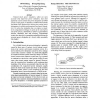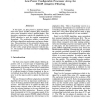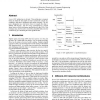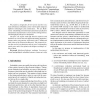ISLPED
1996
ACM
15 years 4 months ago
1996
ACM
Transistlw-level power simulators, which are more accurate than logic-level power estimators, have been popularly used to estimate the power dissipation of CMOS circuits. In thisp...
100
Voted
VLSID
1997
IEEE
15 years 4 months ago
1997
IEEE
I n this paper, we first present a pipelined delayed least mean square (DLMS) adaptive filter architecture whose power dissipation meets a specified budget. This low-power archite...
83
Voted
ISLPED
1999
ACM
15 years 5 months ago
1999
ACM
Modern microprocessors employ one or two levels of on-chip cachesto bridge the burgeoning speeddisparities between the processor and the RAM. These SRAM caches are a major source ...
105
click to vote
ISLPED
1999
ACM
15 years 5 months ago
1999
ACM
A recent trend in low power design has been the employment of reduced precision processing methods for decreasing arithmetic activity and average power dissipation. Such designs c...
102
click to vote
DAC
1999
ACM
15 years 5 months ago
1999
ACM
High performance circuit techniques such as domino logic have migrated from the microprocessor world into more mainstream ASIC designs. The problem is that domino logic comes at a...
ISLPED
2000
ACM
15 years 5 months ago
2000
ACM
Two novel low power flip-flops are presented in the paper. Proposed flip-flops use new gating techniques that reduce power dissipation deactivating the clock signal. Presented cir...
96
Voted
ISLPED
2000
ACM
15 years 5 months ago
2000
ACM
In this paper, we describe area and power reduction techniques for a low-latency adaptive finite-impulse response filter for magnetic recording read channel applications. Variou...
86
Voted
GLVLSI
2000
IEEE
15 years 5 months ago
2000
IEEE
Transitions on high capacitance busses in VLSI systems result in considerable power dissipation. Various coding schemes have been proposed in literature to encode the input signal...
115
Voted
GLVLSI
2000
IEEE
15 years 5 months ago
2000
IEEE
A new ADC architecture is devised. This architecture is memory based, in which the last sample is used to predict the current one, resulting in both power dissipation and energy r...
100
Voted
EUROMICRO
2000
IEEE
15 years 5 months ago
2000
IEEE
We propose a design flow for low-power and low-cost, data-dominated, embedded systems which tightly integrate different technologies and architectures. We use Mathworks’ Simuli...




